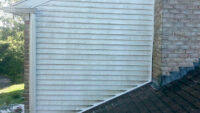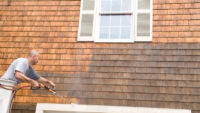Power Washing Services in Southeast Wisconsin
Power washing the exterior of your home before painting is the first step to a successful paint job. If done properly, you’ll enjoy your beautiful new finish without worrying about needing to paint again for years.
Ensuring you have a clean painting surface, free of chalky residues, dirt, and debris, is the first step in the preparation process. Pressure washing also helps to remove loose and chipping paint. If you skip this step prior to painting, you will have a surface that won’t allow the paint to fully stick.
Paint bonds better to a clean surface, which will allow it to resist changes in weather, water from rain, and heat from the sun. These weather elements all contribute to peeling and cracking paint, unless you achieve a good bond with the paint on your siding, trim, or gutters and downspouts.
There are things to watch out for when power washing your house:
- Etching is a problem that results from standing too close when pressure washing. These are indentations or small cuts from the concentrated spray of the water on the siding or trim.
- Letting water get under the siding or breaking through the sealed areas. You have to pay special attention to the angle that you’re holding the sprayer to prevent this from happening.
- Damage to foundation shrubs and other plants in the beds around the house. The water from the pressure washer can easily strip the leaves off plants. This will most likely not kill the plant, but will leave the plant disfigured for the current growing season.
These are the most common steps for power washing a house:
- We start by setting up our equipment and connecting our water lines to your home’s water spigot.
- Using plain water, we begin with rinsing the siding from the top and working our way down. This is done with a lower pressure to remove all the dirt and mildew that has accumulated over the years. These are gradual horizontal passes with a slightly downward angle on the sprayer.
- Once clean, we assess the work and examine any areas that may need to be cleaned further.
- The last step is to allow enough time for the house to dry. This dry time is typically 48-72 hours depending on the type of siding and weather conditions.
Having a clean surface prior to painting is the most important step in the preparation portion of your painting project. However, using a power washer on your home can be tricky, especially if you’re not familiar with the various settings. To avoid the risk of damaging your home, it may be best to put your trust in a trained professional that has the experience and knowledge to give you professional results.
Why Choose Us
At Two Day Painting, we pride ourselves on being your premier choice for power washing services in Southeast Wisconsin. We combine experience, affordability, and local commitment to provide you with unparalleled services and results you can trust. Here are several compelling reasons to choose us for your power washer needs:
- Experienced – With years of experience in the industry, our skilled professionals bring expertise and precision to every project, ensuring exceptional results that exceed your expectations.
- Budget-Friendly Pricing – We understand the importance of staying within budget without compromising on quality. That’s why we offer competitive pricing options tailored to your financial needs, providing excellent value for your investment.
- Locally Owned and Operated – As a locally owned and operated business, we’re deeply rooted in the community. We are committed to delivering personalized service and building long-lasting relationships with our valued customers.
Contact Two Day Painting for Your Power Washing Needs
For superior residential and commercial power washer services in Southeast Wisconsin, trust Two Day Painting to revitalize your property’s exterior. Our experienced team utilizes state-of-the-art equipment to power washhouses and commercial spaces precisely and efficiently. Whether you’re preparing for exterior house painting or simply refreshing your property’s appearance, our professional power-washing company is here to deliver exceptional results. Say goodbye to dirt, and grime, and hello to a fresh, clean surface that’s ready for a vibrant new look. Contact us to schedule your power washing service and take the first step toward enhancing the curb appeal of your home or business.









